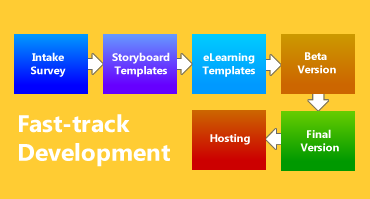Blogs
Fast-track Online Content Development
by Craig A.
Posted on July14, 2021 at 10:50 PM

When you know what you want and just need to get it from design concept to production?
With the use of our online intake forms and storyboard templates, we can fast-track the development of your online training product.
Once we know what you want and how you want it, we can dive right in to developing your training.
eLearning - What are Some of the Benefits?
by Craig A.
Posted on September 13, 2018 at 10:00 PM

E-Learning, eLearning, or Elearning, trying to nail down the correct spelling is difficult enough, let alone trying to get a concensus on what it is and what it isn't. Depending on who you ask, eLearning can mean different things to different people. The most basic and broad definition of eLearning is any learning that focuses on improvement through the use of technology and digital platforms.
eLearning - Keep it Simple...
by Craig A.
Posted on August 28, 2013 at 10:00 PM

KISS…. Don’t overwhelm the learner with too much text, or too many visuals…break learning up into usable chunks…one discrete learning point per frame. Less is sometimes more.
Flash Support Finally Ends by 2020
by Craig A.
Posted on August 28, 2013 at 10:45 PM

The Last Gasps - Flash finally dead by end of 2020
Already most modern browsers block Flash by default and only allow users to opt-in if they choose to. Adobe has announced that the final death throes of flash based content will be by the end of year 2020. Hard choices will have to be made by developers as to whether existing content will need to be redeveloped as HTML5 or to preserve .swf files as they they are now and just let them ride off into the sunset.
Online Tools for Young Learners
by Craig A.
Posted on August 28, 2013 at 10:45 PM

Information Literacy is essential and has everything to do with achieving an essential set of skills needed to be able to navigate through available sources and to decide on the relevancy and accuracy of the materials, however it resembles more of a mission statement or a goal and not really a concrete of example using technology to achieve a specific learning goal. When given the choice of working with concepts or practical examples, I will always choose the “practical” over “the theoretical.”
- Teach ESL in Jeddah KSA
Medical Nursing School seeks ESL teachers for Prep English courses. High salary and good accommodations on secure housing adjacent to the school.
Apply - Female Primary Teachers - Thailand
Beautiful country-side and well-behaved children are just some of the perks of teaching in rural Thailand. #8 openings for Female primary teachers.
Apply